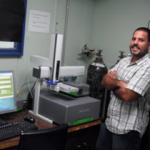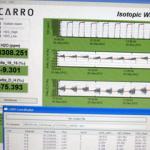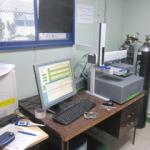COSTA RICA — Ricardo Sánchez-Murillo of the National University of Costa Rica is a Hydrologist who foresees water challenges affecting even the wettest regions of the globe, such as Central America. Applying his experience gained from the University of Idaho-Moscow, he’s intent on finding solutions by studying Costa Rica’s little understood water systems.
Kristen Stanton: Thanks for talking with us about your work, Ricardo. You were recently in Costa Rica working in the isotope lab you're setting up at the National University of Costa Rica (UNA), when you emailed Matt (Wieringa, Ricardo's rep at Picarro) and me right after the 7.6 earthquake that struck on September 5th. We were very happy to get your email and hear that you are fine!
Ricaro Sánchez-Murillo: That makes three of us! I was running samples in the lab when the earthquake hit us. It was the strongest I ever felt. The Picarro continued to perform very well. You can tell people that I am living proof that Picarro is building instruments that can work under extreme conditions!
KS: Thank you! Our engineers will be very happy to get that feedback! Thank God the damage in Costa Rica was not worse. Besides the fact that it resembles paradise, why did you choose to start a stable isotope lab in Costa Rica?
RS: I was born in Costa Rica, so it's home. I obtained my bachelor's degree in chemistry at the National University of Costa Rica (UNA). At UNA, I worked for almost six years as associate scientist in hydrology. As part of my fieldwork, I visited both remote and urban locations, and soon realized that Costa Rica has great water resource potential, however, our water systems are poorly understood. Therefore, I made the decision to study hydrology abroad to get a more comprehensive understanding of hydrological processes. It was during my graduate studies at the University of Idaho (UI), that I began to understand the insights that stable isotopes provide in hydrological processes. I used a Picarro for four years at UI and what I learned inspired me to apply for funding and use a Picarro to study hydrology in Costa Rica.
KS: Your studies abroad include being a doctoral student at UI in the Waters of the West program. Tell us more about that.
RS: I have been a graduate student of the Waters of the West Program at the University of Idaho-Moscow since 2009. My master´s project focused on the potential benefits of waste water treatment plants in streams of the Pacific Northwest of the United States that have been impoverished by loss of marine-derived nutrients. Currently, my doctoral research focus is on the use of stable isotopes, 18O and deuterium, to study hydrological processes in watersheds of the Pacific Northwest, with a special interest in landscape-scale analysis of base flow dynamics.
We are especially interested in collaborative and interdisciplinary research efforts. Our main research interests include:
-
Pollutant transport and modeling of hydrogeochemical processes
-
Use of stable isotopes to understand complex water flowpaths in tropical watersheds
-
Exchange of chemically and climatically important trace gases between the soil/vegetation system and the atmosphere in tropical forest
-
Watershed co-evolution: human and natural systems interaction, and
-
Local, regional, and international transboundary conflicts related with water resources
KS: How will you apply this knowledge to your work in Costa Rica?
RS: The study of stable isotopes will provide us with a better understanding of the hydrological processes in Central America. In his region of the world, water is abundant, so there is less concern about future water resources issues. However, population growths coupled with land use changes are creating critical alterations to our water quality and distribution. Building our knowledge of contaminant transport and mean residence times will be especially useful in understanding forest watersheds as developing better agricultural processes.
In addition, there are a number of other applications we can use this technology to better understand, such as: identification of aquifer recharge sources, tracing solute flowpaths in agricultural landscapes, hydrograph separation in altered urban watersheds, and identification of geothermal activity. Really, the possibilities seem endless!
The Picarro analyzer that Ricaro Sánchez-Murillo is using at the UNA Stable Isotope Labis a Picarro L2120-i, which measures high-precision stable isotope ratios of 18O and D/H.




